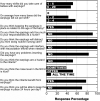A randomized clinical trial evaluating silicone earplugs for very low birth weight newborns in intensive care
- PMID: 19194455
- PMCID: PMC2674530
- DOI: 10.1038/jp.2008.236
A randomized clinical trial evaluating silicone earplugs for very low birth weight newborns in intensive care
Abstract
Objective: To determine whether very low birth weight (VLBW) newborns (<1500 g) wearing silicone earplugs grow larger and perform better on developmental exams than controls.
Study design: VLBW newborns (n=34) were randomized to wearing earplugs or not. Hospital outcomes were abstracted from medical charts by research staff masked to intervention status. Fourteen extremely low birth weight (ELBW) newborns (<1000 g) were also evaluated at 18 to 22 months.
Result: After adjusting for birth weight, 11 surviving newborns in the earplug group were 225 g (95% CI: 45, 405) heavier at 34 weeks post menstrual age than the 13 controls. Six ELBW earplug infants scored 15.53 points (95% CI: 3.03, 28.02) higher than six controls on the Bayley Mental Development Index. Their head circumferences were 2.59 cm (95% CI: 0.97, 4.21) larger.
Conclusion: Earplugs may facilitate weight gain in VLBW newborns. Better outcomes may persist at 18 to 22 months at least in ELBW infants.
Trial registration: ClinicalTrials.gov NCT00565357.
Figures
References
-
- Philbin MK, Lickliter R, Graven SN. Sensory experience and the developing organism: a history of ideas and view to the future. J Perinatol. 2000;20:S2–S5. - PubMed
-
- Bremmer P, Byers JF, Kiehl E. Noise and the premature infant: physiological effects and practice implications. J Obstet Gynecol Neonatal Nurs. 2003;32:447–454. - PubMed
-
- Berens RJ, Weigle CG. Noise measurements during high-frequency oscillatory and conventional mechanical ventilation. Chest. 1995;108:1026–1029. - PubMed
-
- Busch-Vishniac IJ, West JE, Barnhill C, Hunter T, Orellana D, Chivukula R. Noise Levels in Johns Hopkins Hospital. J Acoust Soc Am. 2005;118:3629–3645. - PubMed
-
- American Academy of Pediatrics Committee on Environmental Health Noise: A hazard for the fetus and newborn. Pediatrics. 1997;100:724–727. - PubMed
Publication types
MeSH terms
Substances
Associated data
Grants and funding
LinkOut - more resources
Full Text Sources
Other Literature Sources
Medical



